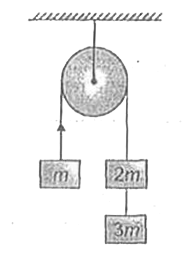In the following four solution, mass M of 1kg is kept in equilibrium , K=100 N/m is all cases. What speed can be given to mass M vertically so that inextensible string S does not becomes slack in subsequent motion. Consider that pulley is ideal and string is massless. :

(A)-P,Q,R , (B)-R, ( c)-P,Q,R, (D)-P,Q,R,S
V=ωA
Where A is distance of equilibrium position from relaxed position of spring. (A)A=mgk=0.1 & ω=√km=10
(B)A=mg4k=0.14 & ω=√4km=20
(C)A=mgk=0.1 & ω=√km=10
(D)A=4mgk=0.4 & ω=√k4m=5
Topper's Solved these Questions
- TEST PAPERSBOOK - BANSALCHAPTER - TEST PAPERSEXERCISE - CHEMISTRY SECTION-2 Part-A ( single correct choice type )
5 Videos
- TEST PAPERSBOOK - BANSALCHAPTER - TEST PAPERSEXERCISE - CHEMISTRY SECTION-2 Part-A ( paragraph type )
1 Videos
- TEST PAPERSBOOK - BANSALCHAPTER - TEST PAPERSEXERCISE - PHYSICS SECTION-1 Part-A ( Multiple Correct Choice type )
5 Videos
- PROBABILITYBOOK - BANSALCHAPTER - PROBABILITYEXERCISE - All Questions
1 Videos
- THERMODYNAMICSBOOK - BANSALCHAPTER - THERMODYNAMICSEXERCISE - Match the column
7 Videos
Similar Questions
If the string & all the pulleys are ideal, acceleration of mass m is :-

View SolutionIn the situation shown below a block A of mass 5 kg is kept on the wedge B of mass 8 kg. All surfaces are smooth and string is massless, smooth and inextensible. Then acceleration of wedge B in m/s2 is?
View Solution
Knowledge Check
If the string & all the pulleys are ideal, acceleration of mass m is :-
 Ag2B0CgDdependent on m
Ag2B0CgDdependent on mTwo masses m and m (m>m) are connected by massless flexible and inextensible string passed over massless and frictionless pulley. The acceleration of centre of mass is
A(m1−m2m1+m2)2gBm1−m2m1+m2gCm1+m2m1−m2gDZeroIn the figure given below, with what accelerating does the block of mass m will move? ( Pulley and strings are massless and frictionless)
Ag3B2g5C2g3Dg2
In the figure given below, with what acceleration does the block of mass m will move? (Pulley and strings are massless and frictionless)

View SolutionIn the figure given below, with what acceleration does the block of mass m will move? (Pulley and strings are massless and frictionless)

View SolutionFind the acceleration of masses m1 and m2 connected by an inextensible string, shown in figure-2.13(a). The string and pulley are assumed to be massless and frictionless.
View SolutionIn the figure given below , with what acceleration does the block of mass m will move ? ( Pulley and strings are massless and frictionless)

View SolutionA particle of mass m is tied to a light string of length l and rotated along a vertical circular path. What should be the minimum speed at the highest point of its path so that the string does not become slack at any position ?
View Solution
